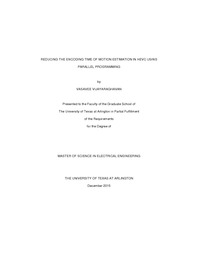
ATTENTION: The works hosted here are being migrated to a new repository that will consolidate resources, improve discoverability, and better show UTA's research impact on the global community. We will update authors as the migration progresses. Please see MavMatrix for more information.
Show simple item record
| dc.contributor.advisor | Rao, Kamisetty R. | |
| dc.creator | Vijayaraghavan, Vasavee | |
| dc.date.accessioned | 2016-01-27T22:06:03Z | |
| dc.date.available | 2016-01-27T22:06:03Z | |
| dc.date.created | 2015-12 | |
| dc.date.issued | 2015-12-02 | |
| dc.date.submitted | December 2015 | |
| dc.identifier.uri | http://hdl.handle.net/10106/25507 | |
| dc.description.abstract | High Efficiency Video Coding (HEVC) is the current state-of-art video codec which is widely being adopted by lot of users. It has close to 50% reduction in encoding time compared to its predecessor, H.264 or AVC (Advanced Video Coding) at the cost of increased complexity. Lot of research is going towards reducing the complexity of this codec, at the same time, maintaining the visual quality that it produces and maintaining the reduced encoding time from its predecessor.
As an effort to decrease the encoding time further, there can be several approaches. Parallel processing is taking a dominant role in many places, especially in Graphics Processing Unit (GPU) and multi-cored processor based applications. Because of the ability of the parallel programming to utilize the multiple cores efficiently at the same time, in place of serial programming, this has been used in many applications which demand quicker completion.
If areas that are parallelizable are identified in any codec (HEVC in this case), the encoding time can be drastically reduced by writing an efficient algorithm.
In parallel programming, it is very important that the parallelized portion has the least amount of dependencies; otherwise it will lead to reverse effects of what is actually expected.
Thus, the success lies in identifying the region of the codec that contributes more towards encoding time and that has least dependencies, and optimizing that portion of the codec.
In this thesis, thorough analysis is done to identify the hot spots in the codec implementation, HM16.7, of High Efficiency Video Coding (HEVC) developed by the JCTVC team. This hotspot analysis is implemented using Intel’s most powerful tool, Intel® vTune™ Amplifier. The results of this hotspot analysis will be functions and loops that use most of the CPU time. Once this is identified, the respective function is targeted to be optimized using Parallel programming with OpenMP. Iterative runs are carried out on the modified code to check whether the code has been reasonably optimized. The final optimized code is tested for encoding videos using metrics such as PSNR (Peak Signal to Noise Ratio), R-D plot (Rate Distortion) and computational complexity in terms of encoding time.
Through optimization of the HEVC HM16.7 encoder, there is an average reduction of ~24.7% to ~42.3% in encoding time with ~3.5 to 7% PSNR gain and ~1.6% to 4% bitrate increase. | |
| dc.format.mimetype | application/pdf | |
| dc.language.iso | en_US | |
| dc.subject | HEVC | |
| dc.subject | Motion estimation | |
| dc.subject | Parallel programming | |
| dc.title | REDUCING THE ENCODING TIME OF MOTION ESTIMATION IN HEVC USING PARALLEL PROGRAMMING | |
| dc.type | Thesis | |
| dc.date.updated | 2016-01-27T22:06:03Z | |
| thesis.degree.department | Electrical Engineering | |
| thesis.degree.grantor | The University of Texas at Arlington | |
| thesis.degree.level | Masters | |
| thesis.degree.name | Master of Science in Electrical Engineering | |
| dc.type.material | text | |
Files in this item
- Name:
- VIJAYARAGHAVAN-THESIS-2015.pdf
- Size:
- 7.436Mb
- Format:
- PDF
This item appears in the following Collection(s)
Show simple item record


